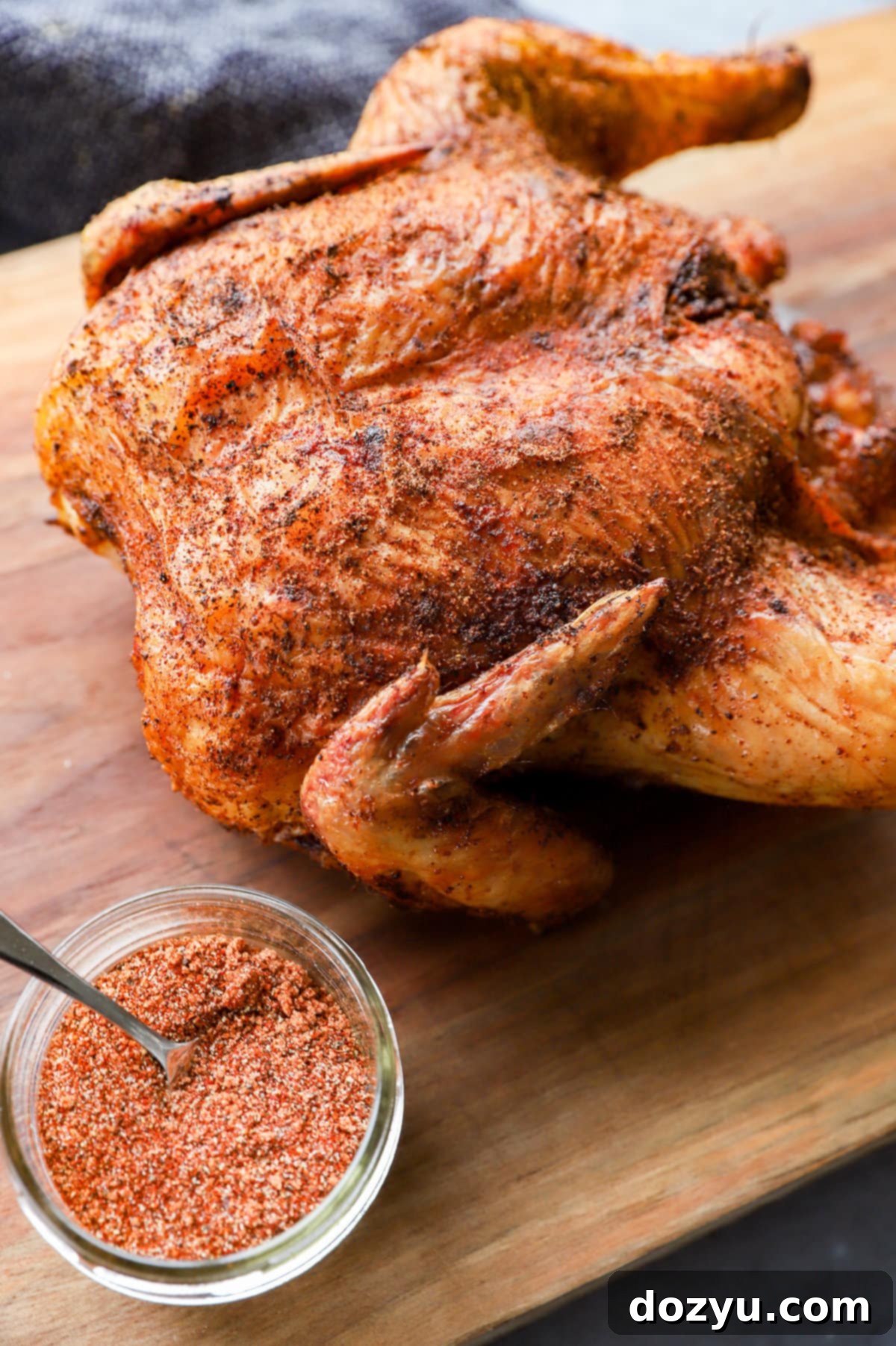The Ultimate Guide to Perfectly Juicy Smoked Whole Chicken with Crispy Skin
Experience the unparalleled flavor of a perfectly smoked whole chicken – tender, incredibly juicy, and infused with rich smoky notes, all crowned with delightfully crispy skin. Coated in your favorite BBQ rub, this recipe is surprisingly easy to master, making it ideal for a casual weeknight dinner or an impressive backyard barbecue feast. Get ready to elevate your chicken game!

table of contents
Toggle
Why You’ll Love This Smoked Chicken Recipe
If you’re dreaming of chicken that’s unbelievably juicy, fork-tender, and bursting with flavor, then this whole smoked chicken recipe is your culinary dream come true. It’s not only simple enough for a casual family dinner but also impressive enough to take center stage at any special gathering, earning rave reviews from everyone at the table.
Smoking meats is a passion of mine, no matter the season – be it the biting cold of winter or the glorious heat of summer. The beauty of a smoker lies in its versatility; you can fire it up whenever the craving strikes. Unlike larger cuts of meat that demand hours upon hours, a whole chicken cooks relatively quickly on a smoker. You’ll only need a couple of hours from start to finish to achieve smoky perfection.
The simplicity of smoking a whole chicken is truly unmatched. All you need is a quality whole chicken and your favorite blend of BBQ spices. That’s it! No complex techniques, no fancy marinades required – just pure, delicious results. This recipe is genuinely accessible for home cooks, not just professional chefs.
The outcome is a magnificent bird with a beautiful golden-brown, crispy skin that gives way to incredibly tender and juicy meat. The slow smoking process infuses the chicken with an irresistible depth of flavor that baking or grilling simply can’t replicate. Plus, if you’re hosting a larger crowd, it’s incredibly easy to load your smoker with multiple chickens, ensuring everyone gets a taste of this sensational dish throughout the year.
Whether you’re looking to avoid heating up your kitchen during a sweltering summer day or simply seeking a fresh, exciting way to prepare chicken on any given weeknight, this recipe offers all the variety and deliciousness you need. It delivers incredible flavor without complicated cooking methods or obscure ingredients, making it a reliable favorite you’ll return to again and again.

Essential Ingredients for Smoked Chicken
Creating an outstanding smoked chicken requires just a few key components. Here’s what you’ll need:
Whole Chicken: Opt for a whole, skin-on chicken weighing approximately 4 to 5 pounds. The skin is essential for achieving that desirable crispy exterior and helps lock in moisture. If you purchase a frozen chicken, ensure it’s fully thawed before you begin cooking to ensure even heat penetration and a safe internal temperature.
BBQ Rub: The secret to infusing your chicken with incredible flavor lies in a good BBQ rub. We highly recommend our homemade BBQ chicken rub, which is crafted to be smoky and savory, perfectly complementing the rich taste of smoked poultry. However, the beauty of this recipe is its flexibility – feel free to use any store-bought or homemade BBQ rub that you love. Don’t be afraid to experiment with different seasoning blends to create unique flavor profiles. For instance, a Greek seasoning could transform your smoked chicken into a Mediterranean delight, perfect for gyro wraps or salads.
Recommended Equipment for Smoking Chicken
To successfully smoke a whole chicken, your primary piece of equipment will be a smoker. While various types of smokers exist, I personally swear by my Traeger grill. It ingeniously combines the functions of both a grill and a smoker, offering incredible versatility. I’ve used mine for years, and it continues to perform flawlessly, consistently delivering amazing results.
For fuel, I typically use Traeger grill signature pellets, but the world of wood pellets and wood chips/chunks offers a wide array of flavors to infuse into your chicken. Each type of wood imparts a distinct smoky profile, allowing you to customize your dish:
- Mesquite: Known for its strong, distinctive flavor, often used for beef but can provide a bold smoke to chicken.
- Hickory: A classic choice for BBQ, offering a strong, bacon-like flavor that pairs wonderfully with poultry.
- Oak: A medium-strength smoke, versatile and a great all-around choice for chicken, providing a balanced flavor.
- Cherry: Imparts a mild, sweet, fruity smoke and a beautiful reddish-pink hue to the chicken skin.
- Apple Wood: Similar to cherry, it offers a milder, sweeter, and fruity smoke that’s fantastic for poultry.
To keep your smoker in top condition, I also recommend having a reliable grill brush, like this Traeger brush, for easy cleaning after each use. A clean grill grate ensures better airflow, more even cooking, and prevents unwanted flavors from previous cooks.
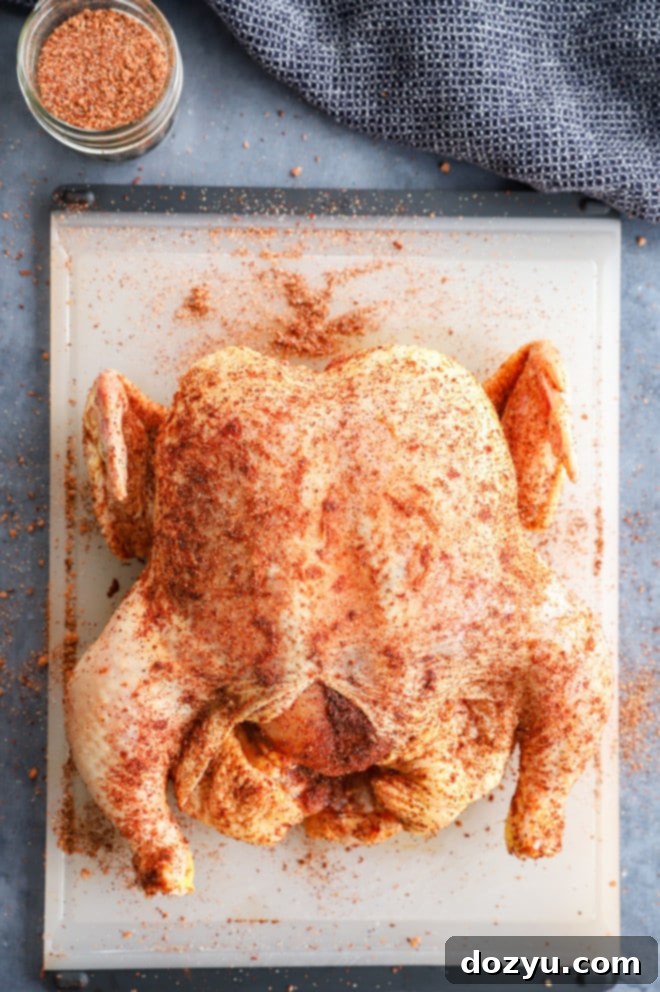
Step-by-Step: How to Make a Whole Smoked Chicken
Follow these simple steps for a perfectly cooked, flavorful whole smoked chicken:
1. Prepare Your Chicken
Begin by carefully removing any giblets or neck from the chicken cavity. Rinse the entire chicken thoroughly under cold running water, both inside and out. The most crucial step for crispy skin is to pat the chicken completely dry with paper towels. Excess moisture on the skin will prevent it from crisping up effectively.
2. Generously Apply Dry Rub
Apply an even and generous coating of your chosen BBQ rub all over the chicken. Don’t forget to get the spice mixture underneath the skin as well, especially over the breast meat. This direct application ensures the flavors deeply infuse the meat, resulting in a more savory and aromatic chicken. For an even more profound flavor, consider letting the seasoned chicken “dry brine” for about 30 minutes at room temperature, or even up to a few hours in the refrigerator. This brief dry marinating process draws moisture from the skin, aiding in crispiness, and allows the rub’s flavors to penetrate more deeply.
While some recipes recommend trussing the chicken (tying its legs and wings to the body), it is entirely optional for smoking. I personally skip this step to keep the process as simple as possible. However, if you prefer a more compact presentation or believe it aids in even cooking, feel free to truss your chicken.
3. Initial Smoking Phase
Preheat your smoker to a steady 250˚F. Once preheated, carefully place the seasoned chicken directly on the smoker grates, breast side up. Allow it to smoke for approximately 2 hours. At this point, check the internal temperature using a reliable meat thermometer, inserting it into the thickest part of the breast without touching bone. Aim for a temperature around 140˚F. If it hasn’t reached this temperature, continue smoking until it does.
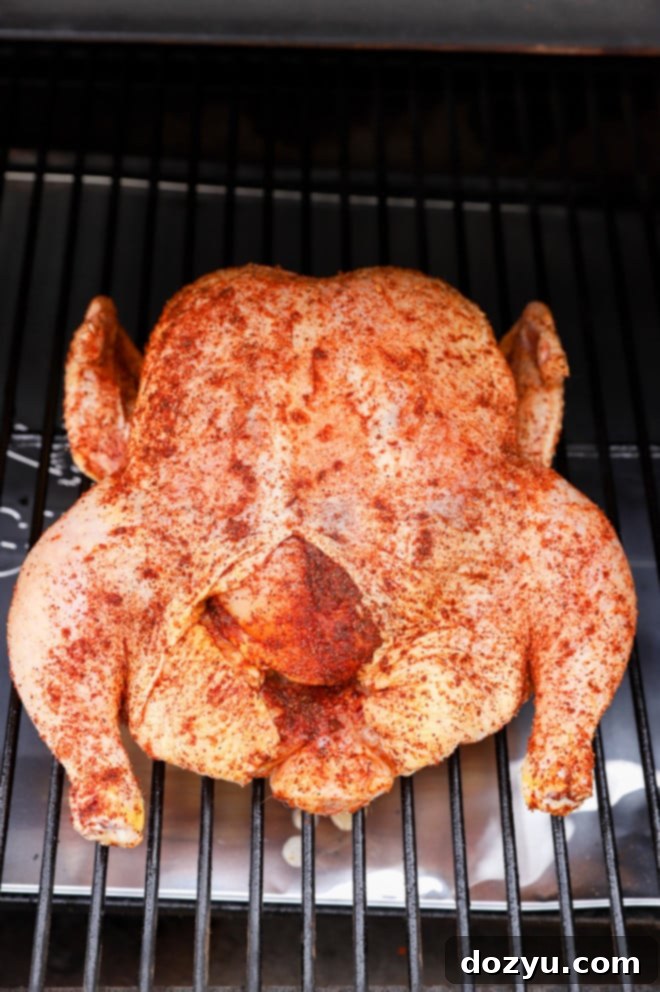
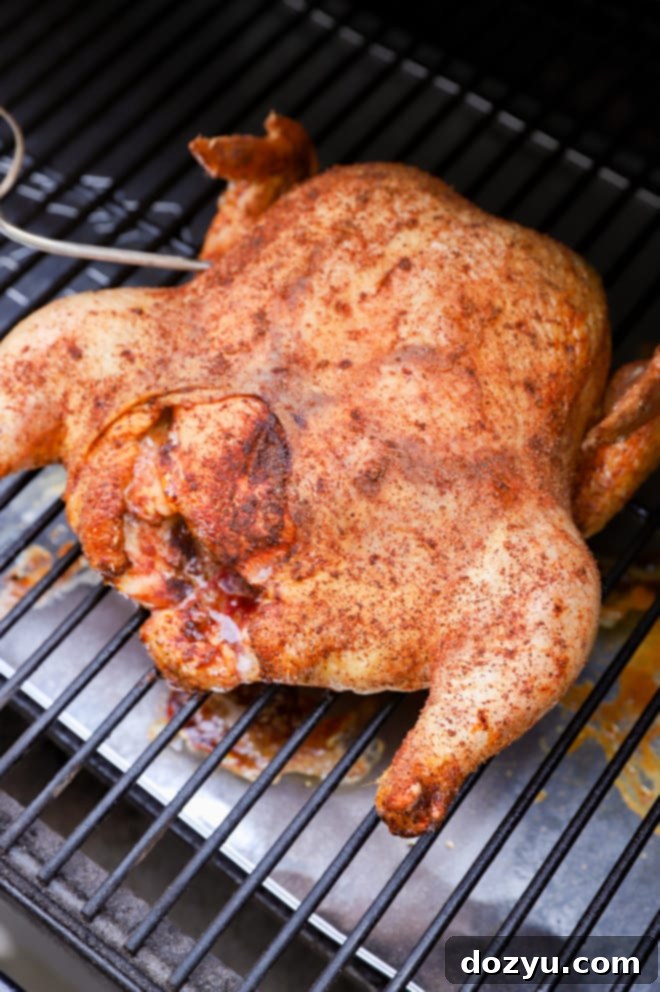
4. Increase Heat for Crispy Skin
After the initial smoking phase, increase the smoker’s temperature to 350˚F. This higher heat blast is crucial for rendering the fat in the skin and achieving that coveted crispy texture. Continue cooking the chicken at this elevated temperature until the internal temperature in the thickest part of the breast reaches between 162˚F and 163˚F. The rise in temperature during this final stage actively contributes to the delightful crispiness of the chicken skin.
5. Crucial Resting Period
Once your chicken reaches the target internal temperature, remove it carefully from the smoker. Transfer it to a clean cutting board and allow it to rest, uncovered, for at least 20 minutes before carving. This resting period is incredibly important: it allows the juices to redistribute throughout the meat, ensuring every bite is moist and tender. During this time, the chicken will also continue to cook slightly, reaching the ideal safe internal temperature of 165˚F through carry-over cooking. After resting, carve your perfectly smoked chicken and serve immediately.
Expert Tips for the Best Smoked Chicken
Achieving a perfectly smoked whole chicken is simple with a few helpful pointers:
- Avoid Overcooking: The biggest mistake with chicken is overcooking, which leads to dry, tough meat. The easiest way to ensure a juicy bird is to use a reliable meat thermometer. A leave-in probe thermometer is ideal, allowing you to monitor the internal temperature without constantly opening the smoker lid, which causes temperature fluctuations. Pull the chicken off the smoker when it hits 162-163°F, as it will continue cooking to the safe 165°F during the rest.
- Customize Your Flavor with Spice Mixes: While I enjoy using a classic BBQ chicken rub, don’t hesitate to get creative! The beauty of smoked chicken is its versatility. Experiment with different spice blends – from spicy Cajun rubs to aromatic Mediterranean seasonings or even a simple blend of garlic powder, onion powder, paprika, salt, and black pepper – to match your desired flavor profile.
- Boost Flavor with a Marinade (Optional): For an extra layer of moisture and flavor, consider a wet marinade before applying your dry rub. A flavorful marinade can penetrate the meat more deeply, especially if allowed to sit for several hours or overnight. You could try a zesty Mexican chicken marinade for a vibrant twist or any other marinade that complements your chosen rub. Just be sure to pat the chicken very dry after marinating and before applying the rub to promote crispy skin.
More tasty chicken recipes to try: Roasted Chicken with Wine and Herbs | Spicy BBQ Pulled Chicken Burger | Refreshing Mango Chicken Salad

What is the Ideal Temperature for Smoking Chicken?
For smoking whole chicken, I generally prefer a temperature range of 225˚F to 250˚F. My go-to is 250˚F because it slightly reduces the overall cooking time without negatively impacting the chicken’s tender texture or smoky flavor. The key is to maintain a consistent low temperature during the initial phase to allow the smoke to deeply penetrate the meat.
The method I highly recommend for smoking chicken involves a two-stage temperature approach: begin by smoking at a lower temperature of 250˚F for a couple of hours. This ensures maximum smoke absorption. After the chicken has developed a good smoky flavor and reached an internal temperature of around 140˚F, you then increase the smoker’s temperature to 350˚F. This higher heat blast at the end is crucial for rendering the fat in the skin and achieving that desirable crispy texture, preventing the rubbery skin often associated with low-temp smoking.
How Long Does it Take to Smoke a Whole Chicken?
The cooking time for a whole smoked chicken can vary based on its size and the smoker’s temperature. Generally, a whole chicken weighing between 4 to 5 pounds will take approximately 2 to 3 hours to cook when your smoker is set to 250˚F using the two-stage temperature method.
If you choose to smoke the chicken at a slightly lower temperature of 225˚F for the entire cook (or just the initial smoke phase), expect the total cooking time to be a bit longer, usually ranging from 2 1/2 hours to 3 1/2 hours. Always rely on a meat thermometer to determine doneness, not just elapsed time.
Should I Wrap My Chicken in Foil While Smoking?
For this smoked chicken recipe, there’s absolutely no need to wrap the chicken in foil. Wrapping typically traps moisture, which can prevent the skin from crisping up – a key goal for this recipe. Instead, simply place the prepared chicken directly onto your oiled smoker or grill grates, allowing the smoke and heat to circulate freely around the bird for optimal flavor and skin texture.
Do I Need to Truss the Chicken Before Smoking?
Trussing a chicken, which involves tying its legs and wings close to its body, is completely optional for smoking. While some chefs truss for more even cooking or a neater presentation, I personally find it an unnecessary step that adds complexity. My goal is always ease and deliciousness, so I typically skip trussing. If you’re confident in your trussing skills or prefer the aesthetic, feel free to do so! Otherwise, rest assured that your smoked chicken will turn out fantastic without it.
Breast Side Up or Down: How to Position Your Chicken on the Smoker
For smoking a whole chicken, always place it on the smoker breast side up. This positioning helps protect the leaner breast meat from drying out during the cooking process. As the chicken cooks, the fat from the skin and thighs will render and baste the breast meat, keeping it moist and juicy. Additionally, having the breast facing up allows the skin to cook more evenly and crisp up beautifully, especially during the higher-heat phase.
How to Achieve Crispy Skin on Smoked Chicken
Achieving crispy skin on smoked chicken can be a challenge with traditional low-and-slow smoking methods, which often result in rubbery skin. However, with the right technique, you can absolutely enjoy both smoky flavor and a satisfying crunch:
- Two-Zone Temperature Method (Recommended for Pellet Grills): If you’re using a pellet grill that can easily switch between smoking and grilling temperatures, this is your best bet. Start with a low smoking temperature (225-250˚F) for the initial phase to infuse maximum smoke flavor. Once the chicken reaches about 140˚F internal temperature, crank up the heat to 350˚F. This higher temperature will efficiently render the fat under the skin, making it deliciously crispy.
- Finishing in the Oven (Broiler Method): If your smoker can’t reach higher temperatures, or if you prefer a different approach, you can finish the chicken in your kitchen oven. Once the chicken reaches 160˚F internal temperature in the smoker, carefully transfer it to a baking sheet. Place it under a preheated broiler (high setting) for a few minutes. Keep a very close eye on it, as broiler heat can quickly burn the skin. This intense heat will crisp up the skin beautifully while the chicken finishes cooking to 165˚F.
- Pat Dry and Dry Brine: As mentioned in the preparation steps, thoroughly patting the chicken dry before applying rub and allowing it to dry brine (even for 30 minutes) significantly helps in achieving crispy skin. Less surface moisture means better fat rendering and crisping.

How to Tell When Your Smoked Chicken is Perfectly Cooked
The most accurate and safest way to determine if your smoked chicken is perfectly cooked is by monitoring its internal temperature with a reliable meat thermometer. You should always insert the thermometer into the thickest part of the breast and thigh, avoiding contact with any bone. For a whole chicken, the target safe internal temperature is 165˚F (74˚C).
However, I recommend a slight adjustment for optimal juiciness: pull the chicken off the smoker when the thickest part of the breast registers between 162˚F and 163˚F. This allows for what is known as “carry-over cooking.” As the chicken rests off the heat, its internal temperature will continue to rise by a few degrees, reaching the safe 165˚F without the risk of overcooking. This method ensures your chicken remains incredibly moist and tender.
Can You Overcook Chicken in a Smoker?
Absolutely, just like any other cooking method, it’s very possible to overcook chicken in a smoker. While smoking is a low-and-slow process designed for tenderness, if the chicken remains on the heat for too long or reaches too high an internal temperature, it will dry out and become tough. This is precisely why diligent temperature monitoring with a meat thermometer is so critical. You want to remove the chicken at just the right moment – precisely 162-163˚F – to capture that perfect balance of juicy tenderness and smoky flavor, avoiding the common pitfall of dry, chalky meat.
How Many People Does a Whole Smoked Chicken Serve?
A whole smoked chicken weighing between 4 to 5 pounds will typically serve 4 to 6 people, depending on appetites and what side dishes are offered. If you’re hosting a larger gathering, the good news is that you can easily smoke multiple chickens simultaneously! As long as your smoker has enough space to allow for proper air circulation around each bird, you can maximize your cooking efficiency and feed a crowd with delicious smoked poultry.
Need some inspiration for dinner this week? Check out my dinner recipes page for more ideas!
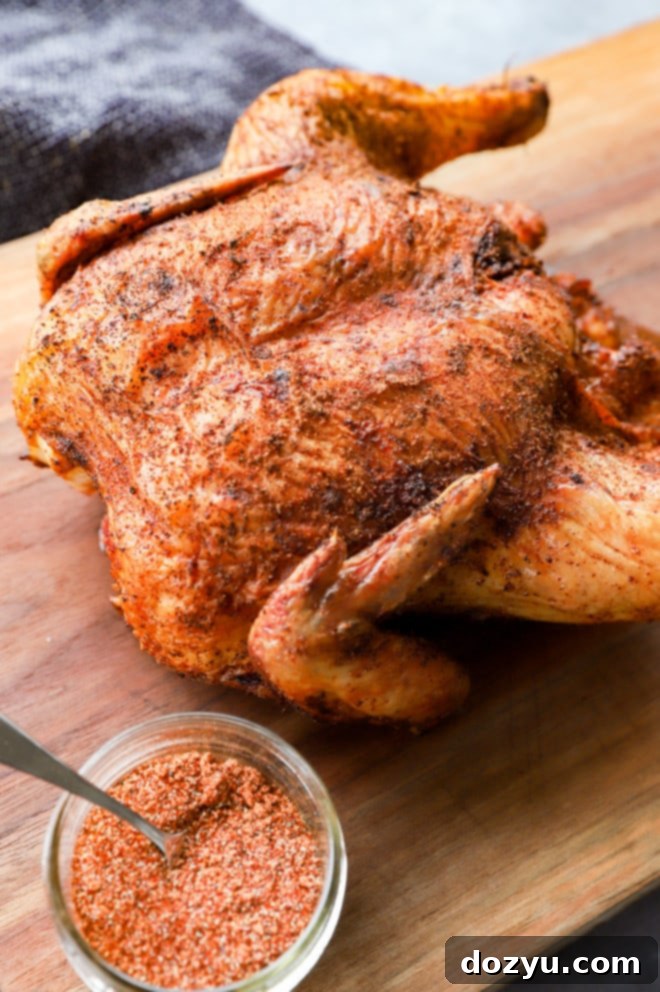
Delicious Sides to Serve with Smoked Chicken
This savory smoked chicken is incredibly versatile and pairs beautifully with a wide array of side dishes throughout the year. Serve it fresh off the smoker, or if you’re in the mood, slather it with your favorite barbecue sauce for an extra kick. The best side dishes often depend on the season:
- For a delightful spring meal, consider light yet satisfying options like tender garlic butter oven-roasted potatoes and carrots, or a creamy risotto with fresh asparagus and peas. These are truly easy side dishes to whip up.
- When summer is in full swing, I always gravitate towards refreshing seasonal favorites such as a sweet and salty melon prosciutto salad, smoky charred corn right off the grill, or a vibrant sun-dried tomato pasta salad (or our lighter summer lemon pasta salad).
- During fall and winter, heartier side dishes provide comforting complements. Think creamy mashed potatoes, rustic oven-fried potatoes and onions, perfectly crisp Brussels sprouts with balsamic glaze, a decadent four-cheese mac and cheese, or another rich creamy risotto. If you appreciate a sweet and savory combination, honey-roasted carrots and parsnips offer an easy, hands-off option. For an utterly indulgent treat, consider this incredible Dickey’s Potato Casserole, brimming with creamy potatoes, crispy bacon, and gooey cheese.
Have leftovers? Transform them into this quick and satisfying chicken caesar pasta salad!
Looking for a refreshing drink? Our citrusy and bright Texas margarita is super simple to make and can easily be scaled up for a big batch cocktail. If you enjoy grapefruit and a hint of spice, a spicy salty dog strikes the perfect balance between tart and fiery.
For an appetizer that utilizes your smoker, prepare this luscious smoked cream cheese with habanero honey while your chicken is cooking.
No time for smoking? Try our faster alternative: this delicious grilled whole chicken recipe!
Storing and Reheating Smoked Chicken
Proper storage and reheating ensure your delicious smoked chicken remains flavorful and safe to enjoy for days.
- Store: Allow any leftover smoked chicken to cool completely to room temperature before transferring it to an airtight container. Store it in the refrigerator for up to 3 to 4 days.
- Reheat: For best results, reheat carved chicken pieces gently. You can warm them in the microwave until heated through, or for a crispier skin, place them in a preheated oven (around 300˚F) for 10-15 minutes. Use the reheated meat as desired – it’s fantastic on salads, in tacos, added to sandwiches, or simply enjoyed on its own.
- Freeze: Cooked and cooled leftovers can be frozen for longer storage. Place portions in a freezer-safe bag or container, ensuring as much air is removed as possible to prevent freezer burn. It will keep well in the freezer for up to 4 months.
- Thaw: When ready to enjoy, thaw frozen chicken overnight in the refrigerator. Once thawed, warm it in the microwave or oven and use as desired in your favorite recipes.
Did you know? Leftover smoked chicken is fantastic in salads! We particularly love transforming it into a hearty and warming curried chicken salad.

More Delicious BBQ Recipes to Try
- For a sweet and savory appetizer or main, these honey BBQ grilled chicken wings are sure to be a hit!
- If you’re not ready to tackle a whole bird, try these incredibly flavorful smoked chicken thighs instead.
- My personal favorite BBQ sandwich, hands down, is a juicy pulled pork burger. I like to pile mine high with a quick coleslaw, crunchy pickles, and crispy fried onions!
- Love blooming onions? You have to try my unique spin: a BBQ grilled blooming onion. It’s glazed with barbecue sauce, making it a tender and slightly healthier alternative to the deep-fried classic.
- For a crowd-pleasing appetizer, serve up a platter of perfectly smoked shrimp with your favorite dipping sauce – they disappear fast!
- And for dessert, these rich and fudgy Biscoff brownies are an irresistible indulgence.
Finally, if you try this whole smoked chicken recipe, please be sure to give it a star rating on the recipe card below and/or leave a comment! I absolutely love hearing about your culinary successes and genuinely take the time to respond to every single comment. Your feedback means the world to me!
Feel free to drop any questions you might have in the comments section as well – I’m here to help.
Oh, and don’t forget to tag me on Instagram if you make the recipe! Seeing these delicious creations come to life in your homes is my absolute favorite thing. It truly inspires me to keep sharing more recipes!

Whole Smoked Chicken Recipe Card
Equipment
-
Traeger Lil Tex Elite 34 Pellet Grill
-
9-Inch Tongs
-
Signature Wood Pellets (e.g., Traeger brand or preferred flavor)
-
Meat Thermometer (leave-in probe recommended)
Ingredients
- 1 whole chicken 4 to 5 lbs, skin-on
- 1/4 cup BBQ rub (your favorite blend)
Instructions
-
Remove giblets and neck from the chicken cavity. Rinse the chicken thoroughly with cold water, then pat it completely dry using paper towels. This step is crucial for crispy skin.
-
Generously apply your preferred dry BBQ rub all over the chicken, ensuring an even coating. For maximum flavor, gently lift the skin and rub some spice mixture directly onto the breast meat as well. You can let it rest for 30 minutes at room temperature for a quick dry brine.
-
Preheat your smoker to a stable temperature of 250˚F (120˚C).
-
Place the prepared chicken on the smoker grates, breast side up. Cook for approximately 2 hours, or until the internal temperature in the thickest part of the breast registers around 140˚F (60˚C) with a meat thermometer.
-
Increase the smoker’s temperature to 350˚F (175˚C). Continue cooking the chicken at this higher heat until the internal temperature in the thickest part of the breast reaches 162˚F to 163˚F (72-73˚C). This final heat blast will help crisp up the skin.
-
Carefully remove the chicken from the smoker and transfer it to a cutting board. Allow it to rest, uncovered, for 20 minutes before carving and serving. During this resting period, the internal temperature will continue to rise to a safe 165˚F (74˚C), ensuring ultimate juiciness.
